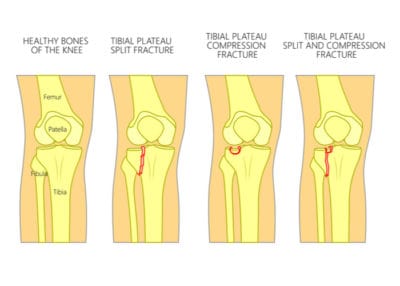Tibial Plateau Fracture Specialist

Do you have osteoporosis, a mineral deficiency, or other underlying conditions that could make your bones soft or brittle? Do you participate in high impact sports such as jumping, running, or football? If so, you may be at risk of sustaining a tibial plateau fracture. Knee fracture doctor, Matthew Provencher, MD provides diagnosis and both surgical and nonsurgical treatment options for patients in Vail, Aspen, Colorado Springs, and the Denver, Colorado area who have experienced a tibial plateau fracture. Contact Dr. Provencher’s team today!
What is a tibial plateau fracture?
The larger and stronger of the two lower leg bones, the tibia (shin bone), is the second-largest bone in the human body behind the femur (thigh bone). The distal end of the femur and the proximal end of the tibia together form the knee joint. The tibial plateau is a relatively flat surface of bone at the proximal end of the tibia. The flat shape provides a low-friction surface that enables the knee joint to bend and straighten. A tibial plateau fracture is a condition in which this flat surface of the tibia becomes broken, often from a high-impact injury such as a motor vehicle collision. Injuries to the tibial plateau can result in a single crack or the bone shattering into several fragments. Individuals with osteoporosis, a mineral deficiency, or other underlying conditions are at a greater risk for tibial plateau fractures, even from a lower-impact injury such as a fall. Dr. Matthew T. Provencher, orthopedic knee specialist serving patients in Vail, Aspen, Colorado Springs, and the Denver, Colorado area, has the knowledge and understanding, as well as substantial experience in treating patients who have experienced a tibial plateau fracture.

Tibial Plateau Fracture Types
What are the symptoms of a tibial plateau fracture?
Individuals with a tibial plateau fracture often experience sharp pain below the knee over the upper portion of the tibia. This pain generally occurs after a high-impact injury. Other common symptoms of a tibial plateau fracture include:
- Swelling and bruising at the site of fracture
- Difficulty with weight-bearing
- Joint pain
- Skin becomes pale as a result of decreased blood flow
- Bone fragment through the skin
How is a tibial plateau fracture diagnosed?
Dr. Provencher will obtain a comprehensive medical history, including the initial injury, and then perform a thorough physical examination. Diagnostic imaging is often necessary for confirming the diagnosis and evaluating the extent of the damage. Multiple x-rays can confirm a tibial plateau fracture and the injury pattern. Computed tomography (CT) scan with a three-dimensional (3D) reconstruction or Magnetic resonance imaging (MRI) may be requested to identify smaller fractures not seen with x-rays or rule out damage to any other structures of the knee joint or proximal tibia.
What is the treatment for a tibial plateau fracture?
Although rare, tibial plateau fractures can result in significant inflammation of the surrounding soft tissues. A significant amount of swelling can jeopardize the blood supply to the lower leg and foot requiring emergency surgery. If a tibial plateau fracture is suspected, immediate medical attention by a medical professional or orthopedic knee specialist is strongly advised.
Non-surgical treatment:
Conservative therapies may be adequate to heal a confirmed tibial plateau fracture that is small and did not result in bone displacement. Conservative therapies may also be recommended for patients who are less active, have poor health overall, or experience chronic skin infections. The knee will be immobilized to ensure the bones remain aligned during the healing process. Weight-bearing and movement will also be restricted during the early stages of recovery. Sequential x-rays and regular follow-ups are essential for monitoring bone alignment throughout the recovery period. A second injury, or lack of compliance with medical advice, can cause bone displacement and require surgery.
Surgical treatment:
In the event of failed conservative therapy, bone displacement, or the tibial plateau fractured into multiple pieces, surgical intervention is necessary to correct and maintain bone alignment and restore function to the knee joint. A tibial fracture is surgically repaired using rods, plates, and screws. A bone graft, either from the patient (autograft) or a donor (allograft), or a bone substitute may be needed if the bone fragments are lifted. Some tibial plateau fractures may require an external fixator prior to surgical reconstruction. This temporary device stabilizes the knee joint by attaching pins above and below the knee joint that are connected to bars outside of the skin.
For more information on tibial plateau fractures, or the excellent treatment options available, please contact the office of Dr. Matthew T. Provencher, MD, orthopedic knee specialist at The Steadman Clinic, serving Vail, Aspen, Colorado Springs, and the Denver, Colorado area.